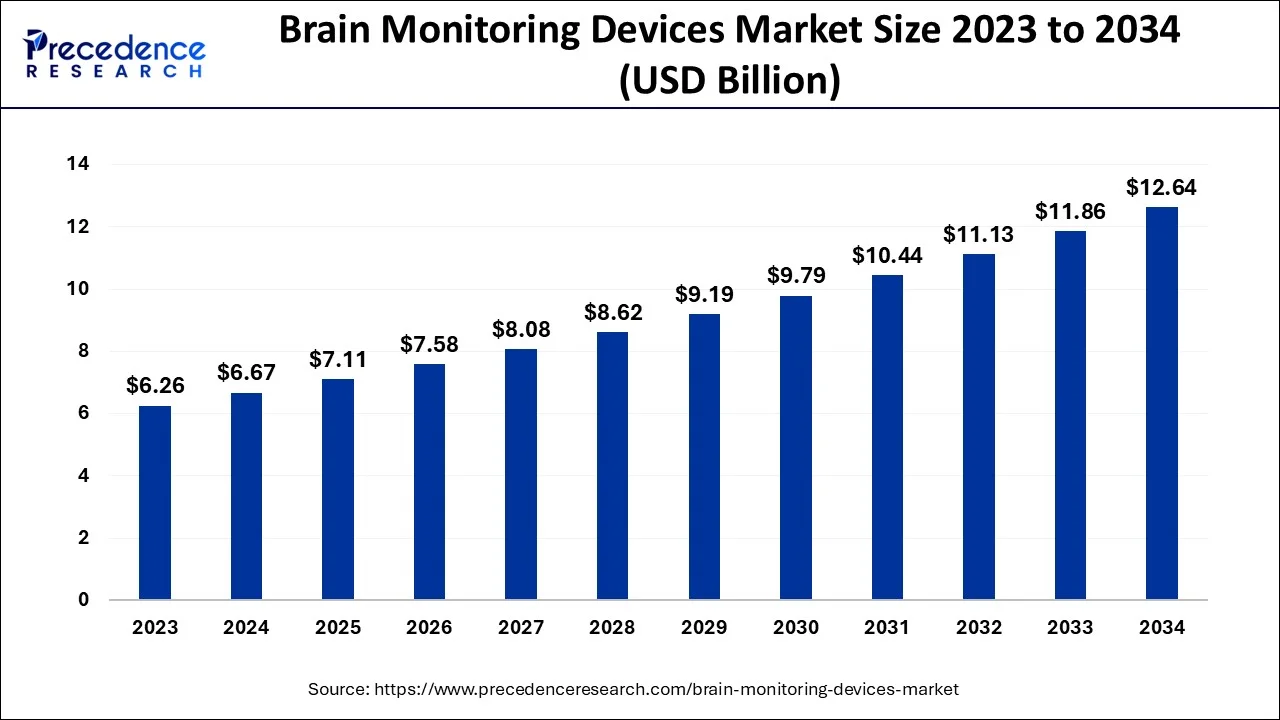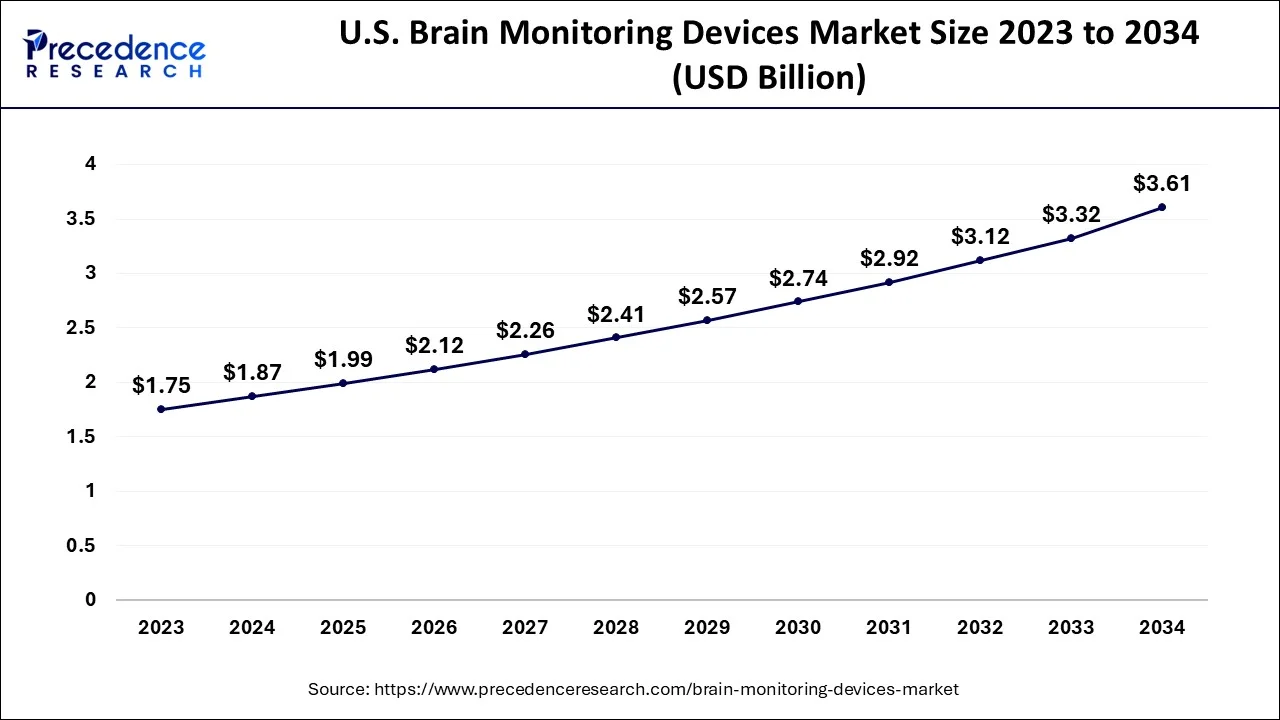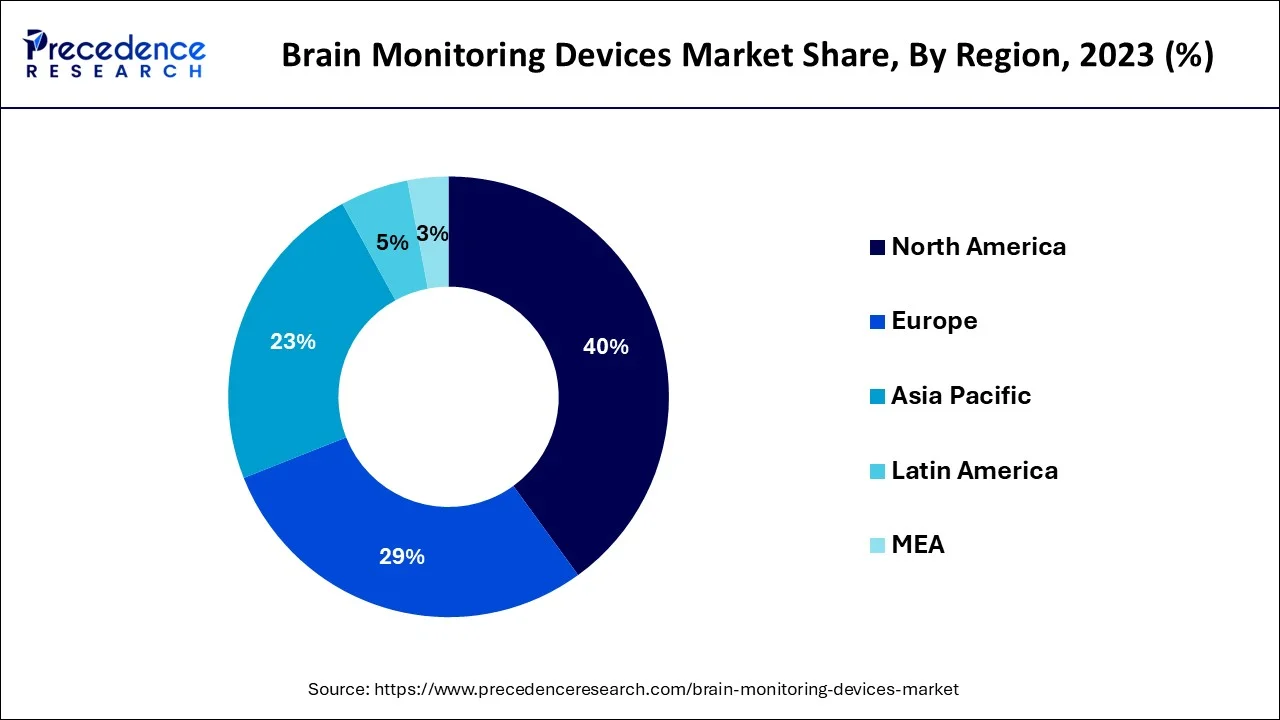List of Contents
Brain Monitoring Devices Market Size and Forecast 2025 to 2034
The global brain monitoring devices market size was estimated at USD 6.67 billion in 2024 and is anticipated to reach around USD 12.64 billion by 2034, expanding at a CAGR of 6.60% from 2025 to 2034.

Brain Monitoring Devices Market Key Takeaways
- North America dominated brain monitoring devices market in 2024.
- By product, the doppler devices segment dominated the market in 2024.
- By end user, the hospitals segment will gain a significant market share over the forecast period 2025 to 2034.
U.S. Brain Monitoring Devices Market Size and Growth 2025 to 2034
The U.S. brain monitoring devices market size was evaluated at USD 1.87 billion in 2024 and is predicted to be worth around USD 3.61 billion by 2034, rising at a CAGR of 6.80% from 2025 to 2034.

North American region has dominated the market in the past and it shall show significant growth in the coming years. They are the variability of excellent healthcare infrastructure in the North American region will play a significant role in the growth of this market during the forecast period. The availability of favorable reimbursement policies in North America especially in some other regions will lead to significant growth in the market during the forecast period.

Constant research and development in the field and the amount of fund received by the private as well as the public companies in order to come up with elevated products in the market are all expected to play a significant role. Geriatric population has increased in the recent years and this is another reason that will lead to an increase in the number of neurological disorders like epilepsy, Parkinson's disease etc. as the number of cases of neurological disorders have also increased in the North American region the demand for brain monitoring devices will grow well.
Technological developments are possible due to a good healthcare infrastructure in this region. Advanced Research in the field of Monitoring devices the devices with advanced features will be made available in the market in the near future. Apart from the growth of this market in the North American region there will be a significant growth in the Asia Pacific region too.
Europe is observed to grow at a considerable growth rate in the upcoming period, driven by an aging population and a rising burden of neurological diseases. Improved public healthcare systems and increased funding for neurotechnology research are fostering strong adoption of advanced diagnostic and monitoring technologies. Countries like Germany, the UK, and France are leading the way, investing in next-generation devices and the integration of artificial intelligence for early diagnosis and ongoing monitoring. Productive partnerships between research institutions and medical device manufacturers, alongside strict regulations guaranteeing product quality and effectiveness, are maintaining the region's progressive approach to managing brain health and long-term neurological care.
Germany
Germany is at the forefront of the European brain monitoring devices market, supported by its sophisticated healthcare infrastructure and dedication to medical innovation. The country prioritizes early detection and management of neurological diseases, underpinned by strong clinical research and collaborations between public and private sectors. Its well-regulated market facilitates the seamless adoption of advanced brain monitoring technologies, including multimodal neuroimaging and AI-driven analytics. Germany's commitment to high-quality care and technological integration establishes it as a central hub for neurological diagnostics across Europe.
Asia Pacific is the fastest growing market for the brain monitoring devices market with a significant CAGR during the forecast period, propelled by increasing awareness of neurological disorders, the enhancement of healthcare infrastructure, and rising investments in medical technologies. Countries such as China, India, and Japan are experiencing a significant rise in the demand for EEG, MEG, and intracranial pressure monitors due to the higher occurrence of strokes, epilepsy, and traumatic brain injuries. Government initiatives supporting digital health, along with the arrival of international companies and startups providing affordable and portable monitoring solutions, are further driving this growth. The region's vast population offers considerable prospects for market expansion.
China
China distinguishes itself in the Asia Pacific brain monitoring devices market due to its growing investments in healthcare infrastructure and innovation in medical technology. The increasing elderly population and the rising prevalence of neurological disorders are driving up the demand for EEG and other brain monitoring technologies. Government initiatives promoting local manufacturing and digital health solutions have also enhanced accessibility, making China an essential player in regional growth and technological progress in brain health.
Market Overview
The brain monitoring devices are known as device is used for new row diagnostics. These devices help in detecting as well as monitoring the various brain functions by carrying out the recording of any sort of abnormalities present in the functioning of the brain of a human being. It helps in monitoring and diagnosing the neural activities of the brain and the electrical activities of the brain. These devices which are used for the monitoring of the brain are extremely beneficial in displaying as well as analyzing the conditions of the neurology of a person. They help in understanding the functioning as well as the structure of a person's pain. When it comes to a few medical conditions of the brain which are extremely serious brain monitoring plays a significant role in understanding the amount of injury that the brain has undergone. The need for the devices used in the monitoring of the brain is expected to have a significant growth in the coming years as they help in understanding the extent of the neurological injury caused to a particular patient.
Constant research and development in this field has led to the adoption and implementation of various techniques to the devices used in brain monitoring. Many different types of devices have been recently introduced in the market that help in providing enhanced features. All of the brain functions can be tracked with the help of these devices which are intracranial pressure monitors, and magnetoencephalography. Transcranial Doppler and cerebral oximeters will also play a significant role in the brain monitoring functions. There are many such devices available in the market and the demand for these devices will continue to grow in a significant manner during the forecast period.
Brain Monitoring Devices Market Growth Factors
The need for the devices used in the brain monitoring are expected to have a significant growth in the coming years as these devices help in tracking the functions of the brain and they also help in understanding the velocity at which the blood flows through the arteries and the veins when there are cases of epilepsy. They also help in analyzing and monitoring the neural activity as well as the electrical activity of the brain. In the conditions of brain death these devices help in understanding the blood flow to the brain and help in providing a therapeutic way for the patient to cure. As the cases of severe accidents have increased in the recent years so demand for all of these devices will continue to grow well in the coming years.
Constant research and development in the field has led to the introduction of monitoring devices that are automated and these automated devices used in the monitoring of the brain are expected to provide a significant growth in the coming years. The use of these devices in the hospitals as well as the clinics are extremely important in understanding the impact data selective or the anesthesia has on the brain of the person. As the cases of the disorders of the brain have increased in the recent years the need for the monitoring devices is expected to grow. Epilepsy dementia and Parkinson's disease are the disorders that have led to the growth of this market. Neurological infections, multiple sclerosis and strokes are some of the conditions that will help in the significant growth of the market. The market growth will be fueled due to the growth in the cases of cerebral palsy.
- Neurological conditions and neurological disorders are progressive in nature due to which the need for these devices will grow
- Increase in the number of the cardiac disorders and the diseases of sickle cell will lead to an increased use of these devices.
- In recent years the number of approvals received by the brain monitoring devices through the regulatory bodies have also increased
- The need for the brain monitoring devices is expected to grow in the near future as the regulatory approvals have played a significant role in providing advanced and innovative products in the market.
Market Scope
| Report Coverage | Details |
| Market Size in 2024 |
USD 6.67 Billion |
| Market Size in 2025 |
USD 7.11 Billion |
| Market Size by 2034 |
USD 12.64 Billion |
| Growth Rate from 2025 to 2034 | CAGR of 6.60% |
| Base Year | 2024 |
| Forecast Period | 2025 to 2034 |
| Segments Covered | Product, Procedure, Application, End User, and Geography |
| Companies Mentioned | Medtronic PLC, Advanced brain monitoring incorporated, General Electric company, Siemens AG, Compumedics limited |
Market Dynamics
Key Market Drivers
Prevailing neurological disorders and the increase of the neurological disorders
- The growing number of cases of epilepsy, dementia, Huntington's disease, Parkinson's disease, multiple sclerosis, cerebral palsy, stroke and headache disorders will lead to an increased demand for the brain monitoring devices in the coming year. As the cases of neurodegenerative diseases and psychiatric cases have increased in the recent years the need for these devices will grow significantly. As the geriatric population of the world has also increased the number of people suffering with neurological disorders has also increased.
Key Market Challenges
- Highly complex nature of the brain monitoring devices - The brain monitoring devices are complex and the procedures that are involved in the use of these devices are almost always expensive due to which the market growth will be restrained in the coming years. The reimbursement policies in some of the developing nations is not very favorable due to which the high price of these procedures will hamper the growth of the market in the long run. There are many other indirect expenses incurred on the maintenance of these devices due to which the market growth will be hampered in the long run.
- Unaffordable treatments - most of the developing nations many patients cannot afford these neurological treatments due to which the market growth will be restrained. The health care facilities of these regions are extremely reluctant to make investments in the systems that are technologically advanced and this is another reason why the market growth will be hampered
Key Market Opportunities
- Minimally invasive or non-invasive devices - The growing demand for non-invasive procedures has led to the increased adoption of technologically advanced devices for brain monitoring. The invasive procedures are extremely risky and painful. There's a growing inclination towards the minimally invasive procedures and devices as they have many advantages as compared to the invasive devices used for monitoring. Most of the market players across the globe are inclined towards making the adoption of technologically advanced devices in order to fulfill the growing demand for noninvasive order minimally invasive procedures performed in the monitoring of the brain functions.
Product Insights
On the basis of the product used in the monitoring of the brain, the Doppler devices segment is expected to have a significant growth in the coming year. As there has been an increase in the cases of sleep disorders, neurogenerative disorders and psychotic disorders the need for these devices is expected to grow well in the coming years. As most of the devices used in the monitoring of the brain are portable and they are also wearable the amount of convenience that these products offer will lead to an increased demand of these devices.
Most of these innovative products are available for use at the home of the patient and the growing awareness among the patients regarding the availability of such products will increase the revenue generated through this segment in the coming years.
End-User Insights
Based on end users, the hospitals segment is expected to have the largest market share in the coming years. As the monitoring of the brain requires expensive devices and machineries and the process is complex due to which the need for trained professionals cannot be avoided. Nurses and doctors at the hospitals are trained in performing these functions due to which the use of the complex devices which are used in the monitoring of the brain are easily available at the hospitals or the specialty care centers where exact reports can be obtained with the help of these people. Most of these devices are extremely expensive and acquiring these devices for home use is not possible. The number of patients that visit the hospitals for various brain conditions is significantly more as compared to any other segments due to which the availability of such devices is more in the hospitals and the use of these devices is also significantly more as compared to all the other segments in the market.
Apart from the growth of the hospitals segment the growth in the diagnostic centers is also expected to be good in the coming years. the specialty centers or the diagnostic centers have trained technicians that perform these brain monitoring functions for coming up to a conclusive report do to which the need for these devices will grow in these centers.
Brain Monitoring Devices Market Top Companies
- Medtronic PLC
- Advanced brain monitoring incorporated
- General Electric company
- Siemens AG
- Compumedics limited
Recent Developments
- In February 2025, Neurosoft launched a new EEG system that boasts improved sensitivity and portability, designed for monitoring brain activity in both clinical and homecare environments. This device utilizes AI algorithms to enhance the diagnosis of neurological conditions such as epilepsy and sleep apnea, representing a notable step forward in accessible neurodiagnostic tools.
- In January 2025, CergenX revealed that its Wave device for neonatal brain monitoring received the FDA's Breakthrough Device Designation. This recognition highlights the device's potential to provide innovative solutions for tracking brain activity in newborns, meeting essential needs in the early detection and management of neurological conditions.
- In April 2025, the neurotechnology firm BrainCo announced its plans to expand operations into Hong Kong. Renowned for creating brain-computer interface products, BrainCo aims to capture the Asian market by bringing its innovative brain-monitoring devices and technologies closer to a larger customer base in the region.
- Chalgren enterprises was acquired by Rhythmlink international in the year 2020 which will help in expanding the portfolio of the company by acquiring new products for monitoring of the nervous system and the functioning of the brain.
Segments Covered in the Report
By Product
- Electroencephalography (EEG) Devices
- Magnetoencephalography (MEG) Devices
- Transcranial Doppler (TCD) Devices
- Intracranial Pressure (ICP) Monitors
- Cerebral Oximeters
- Magnetic Resonance Imaging (MRI) Devices
- Computerized Tomography (CT) Devices
- Positron Emission Tomography (PET) Devices
- Sleep Monitoring Devices
- Electromyography (EMG) Devices and Accessories
By Procedure
- Invasive
- Non-invasive
By Application
- Epilepsy
- Dementia
- Parkinson's Disease
- Huntington's Disease
- Headache Disorders
- Stroke
- Traumatic Brain Injuries
- Sleep Disorders
- Other
By End User
- Diagnostics enter
- Hospital
- Others
By Geography
- North America
- Europe
- Asia-Pacific
- Latin America
- Middle East & Africa (MEA)
For inquiries regarding discounts, bulk purchases, or customization requests, please contact us at sales@precedenceresearch.com
Frequently Asked Questions
Ask For Sample
No cookie-cutter, only authentic analysis – take the 1st step to become a Precedence Research client